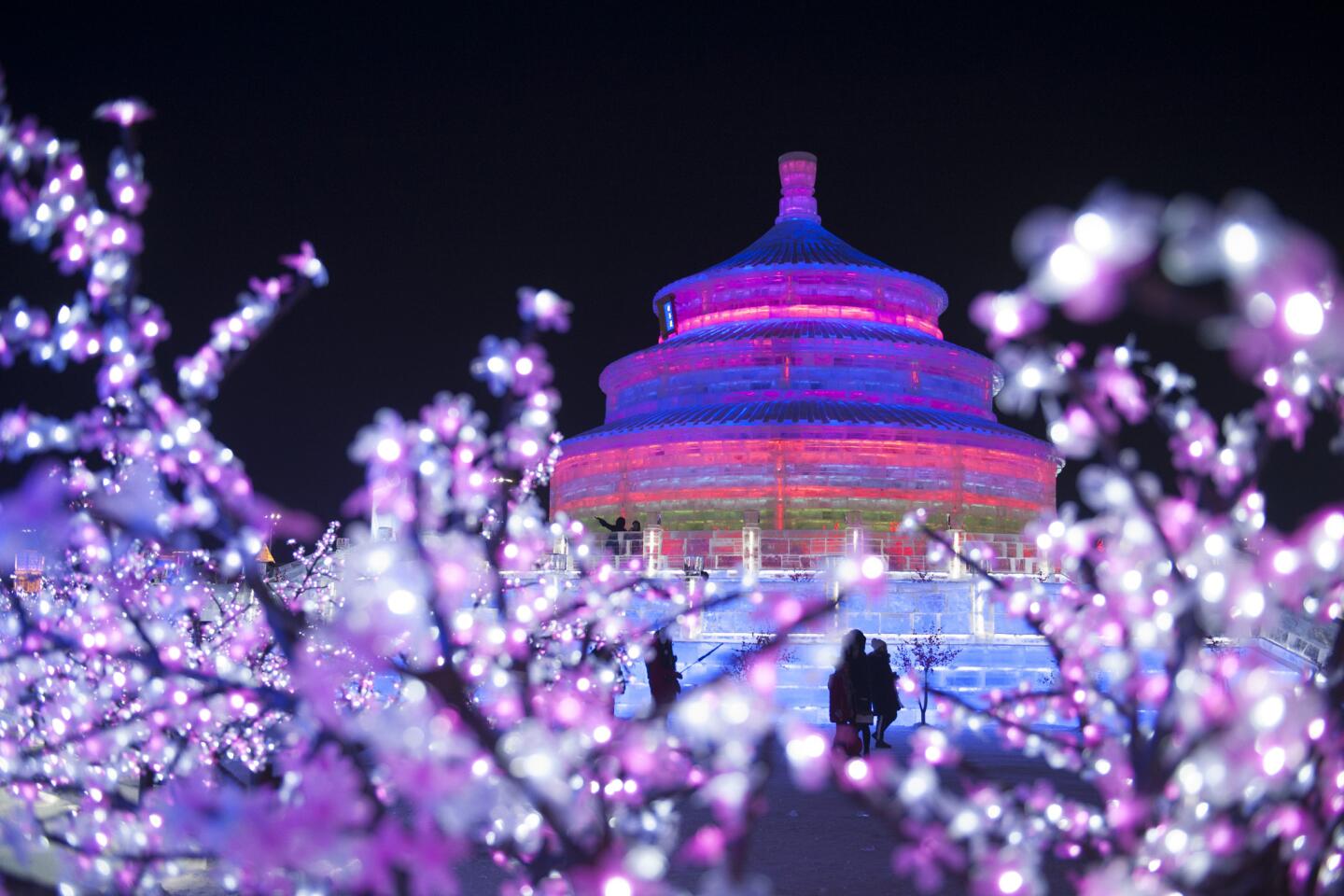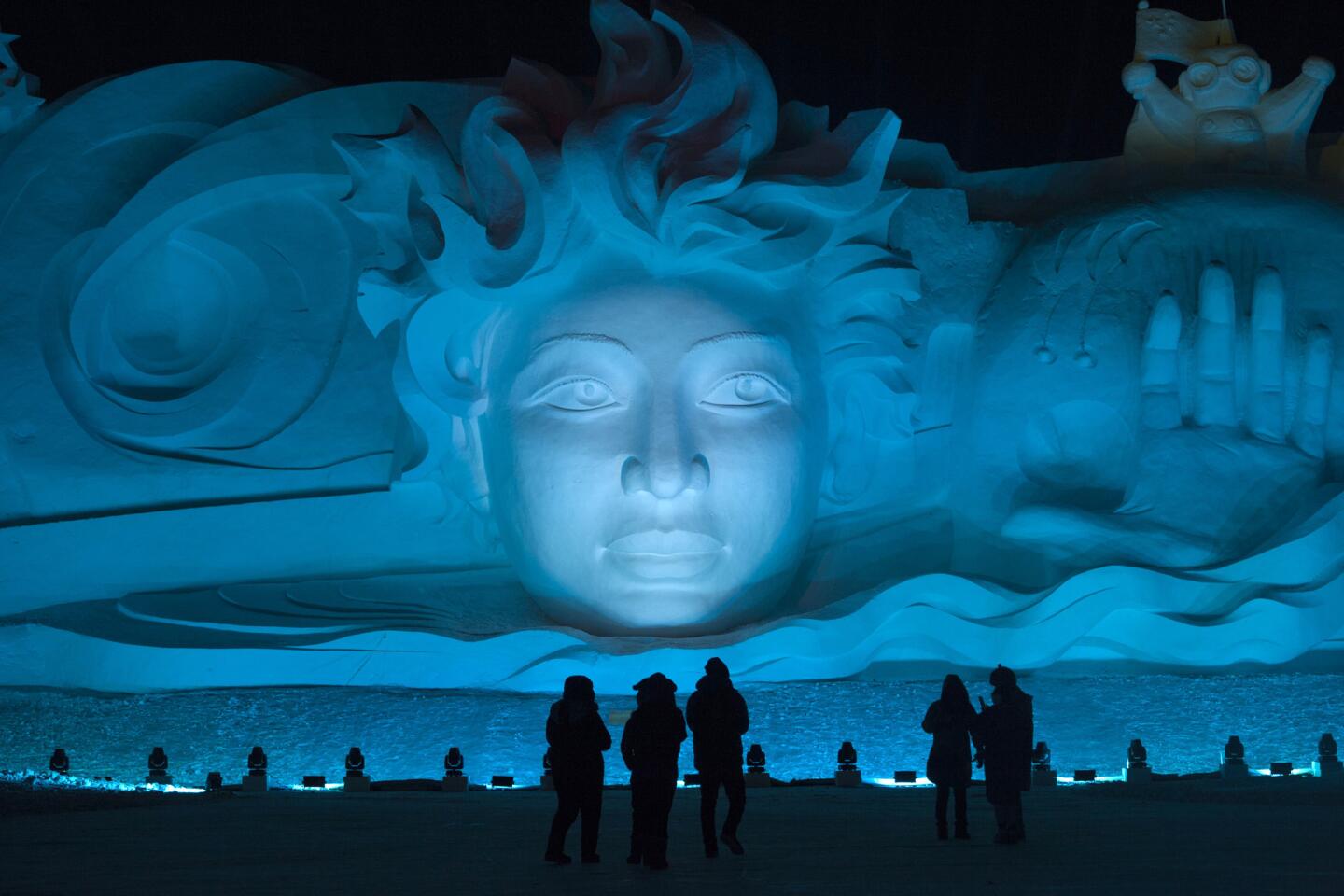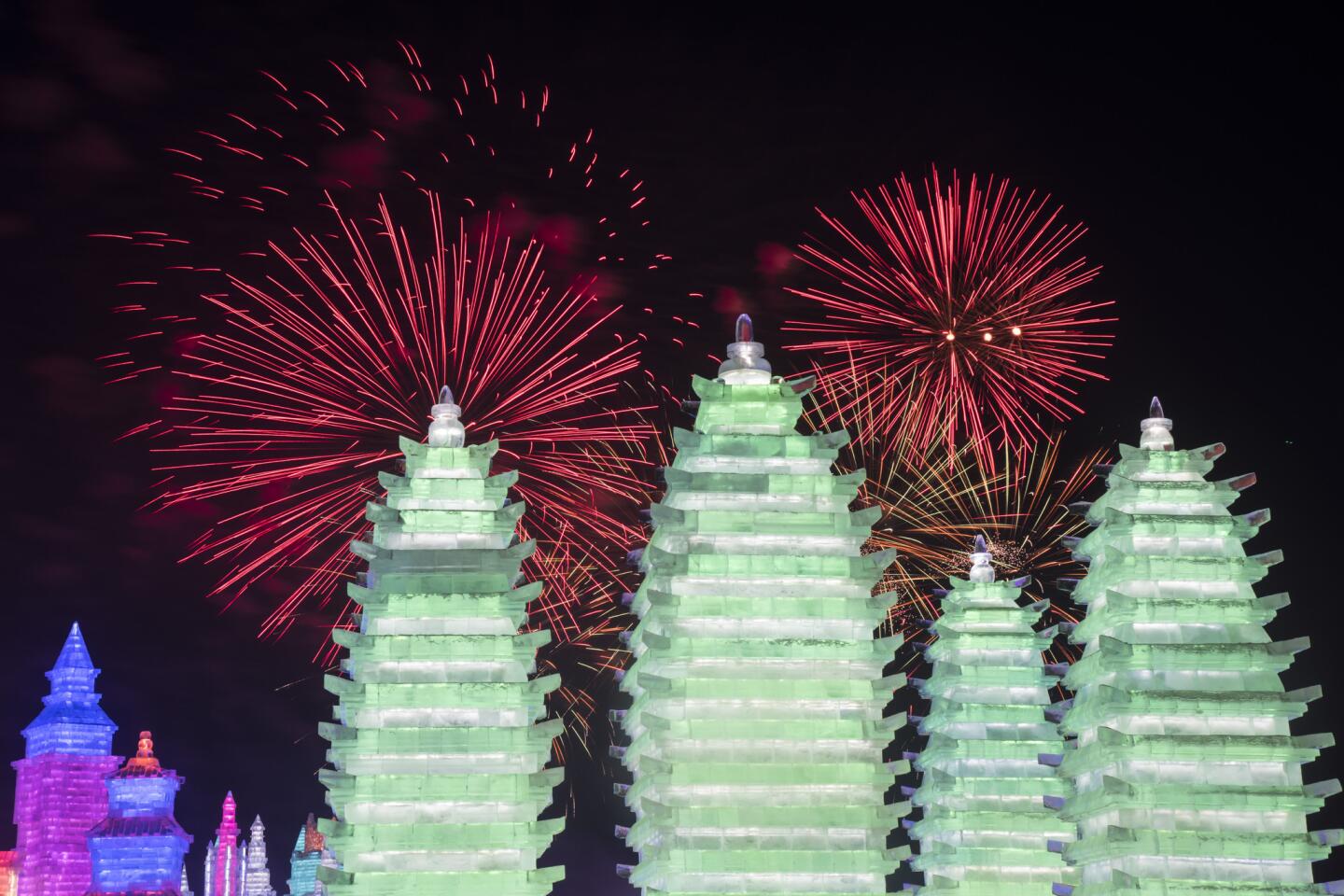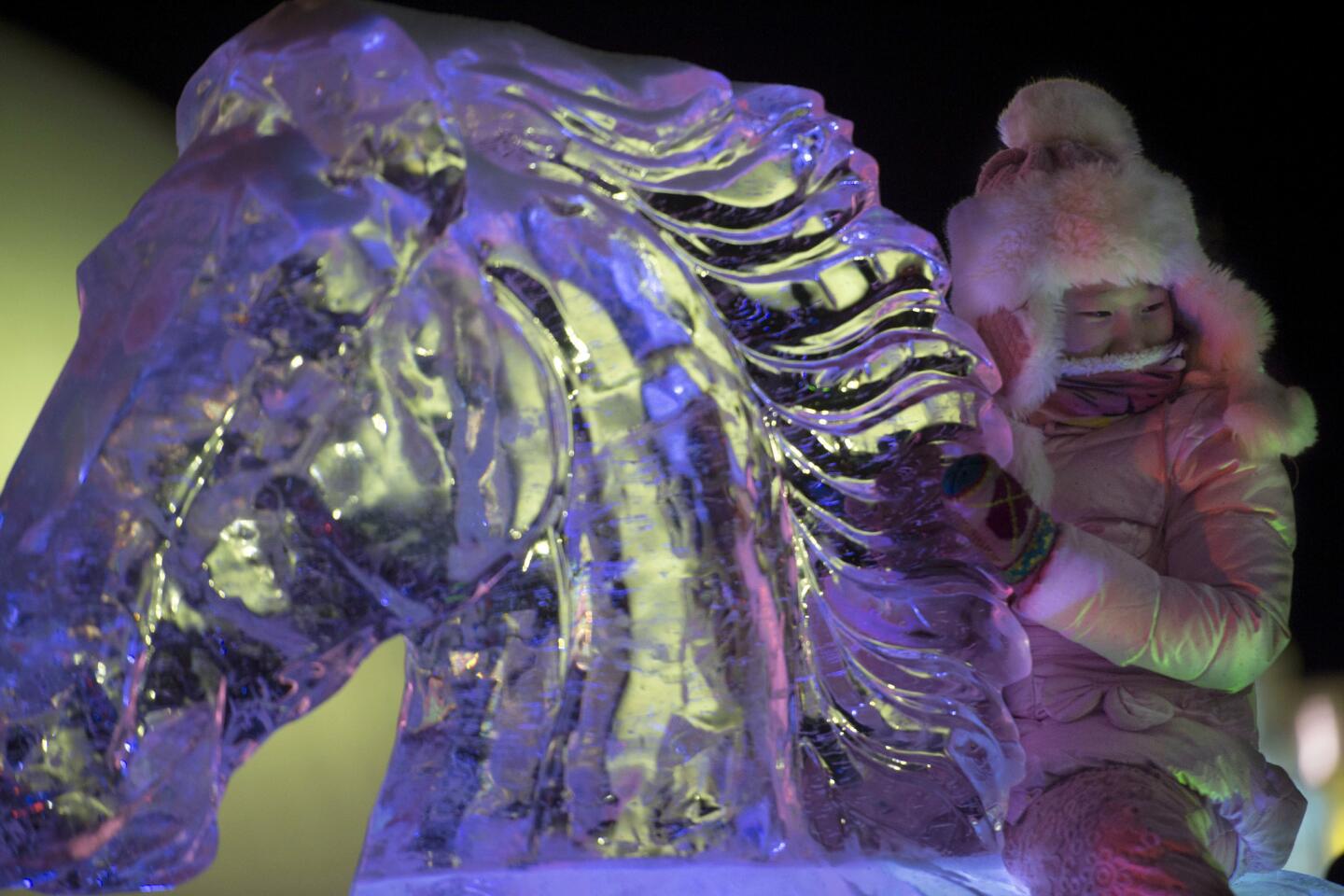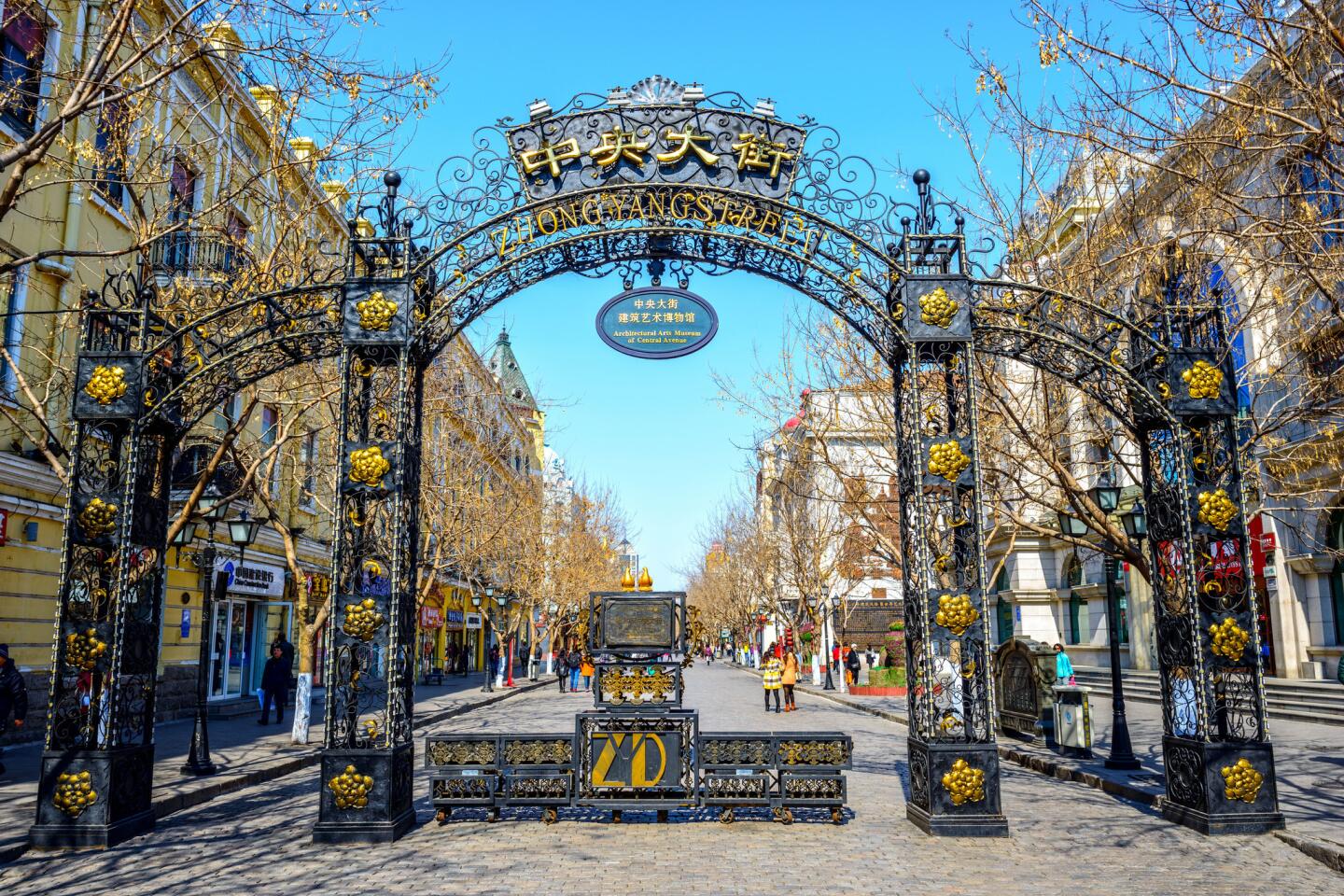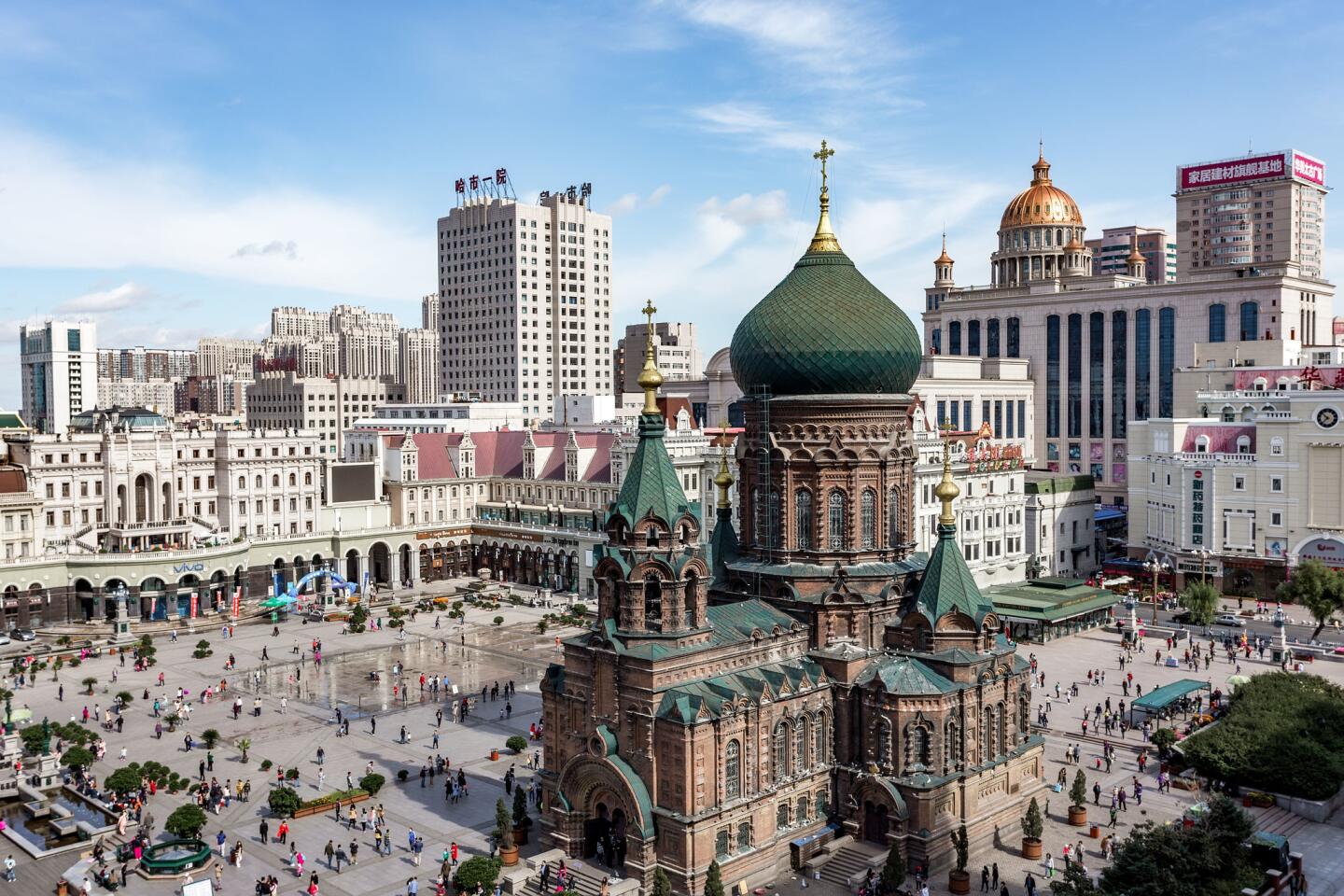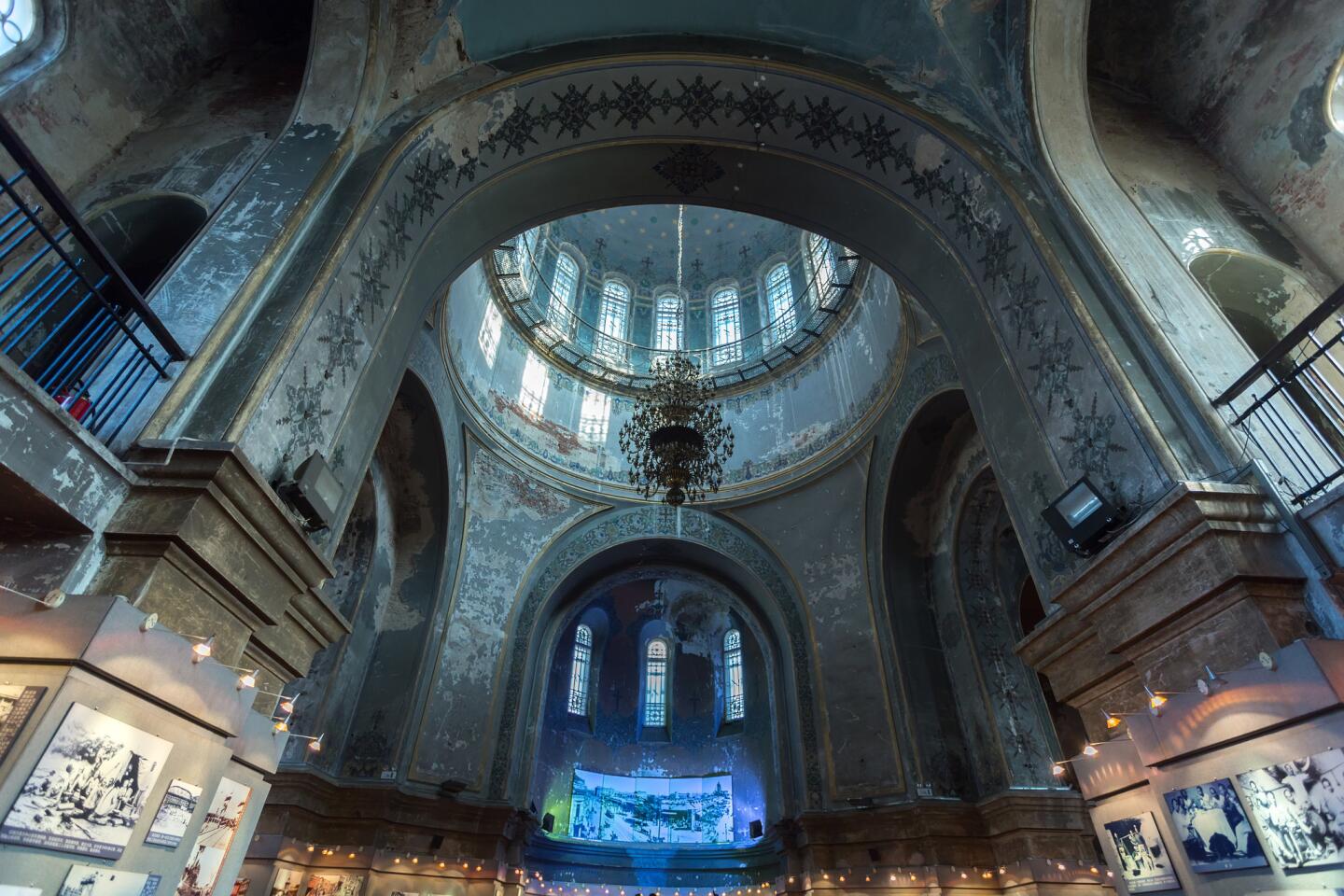Harbin Ice Festival sculptures create a fairy tale setting — a very cold fairy tale
The Harbin International Ice and Snow Sculpture Festival is what I imagine would happen if a Vegas designer decorated the North Pole.
When I first saw pictures a decade ago, the festival became an immediate bucket list item. I’m not sure why it captured my imagination, but I think it was its enormity — it covers about 112 football fields — and how incredibly different it was from anything I’d seen on my two previous trips to China.
Plus, ice slides two stories tall. Who could resist?
I had toddlers 10 years ago and wanted to wait to visit until they were old enough to appreciate the spectacle. In practical terms, I also wanted them to haul their own gear through airport security and be able to entertain themselves for the 20-plus hours of travel.
In February 2018, my sons were 10 and 13 and were game for a quick visit to Harbin on our way to the Olympics in Pyeongchang, South Korea.
It takes only two or three days to see Harbin’s main attractions, although those who want to stay longer can visit a ski resort and a snow village outside of town. We were happy to move on after three nights and two full days.
The festival runs January through late February each year, depending on when attractions start to thaw. The ice part is filled with structures made from giant blocks of ice said to be taken from the frozen Songhua River, which runs through the town. They blew me away when I first saw pictures, and seeing them in person was even more impressive than I imagined.
We arrived at the festival shortly before sunset so we could appreciate the glass-like appearance of the buildings before they were illuminated. Music played everywhere as we wandered streets of packed snow.
Many of the structures resembled the architecture of temples in various parts of Asia. The walls of ice, shooting straight up, were massive, and I couldn’t resist touching them. They seemed so impossible I half expected to learn they were made of plastic.
As night fell, brightly colored lights slowly came on inside the ice, making the park festive in a peculiar neon way.
The entry fee at night is 330 yuan, or about $49. It includes stage shows, ice slides and ice-cycle riding. The ice cycles were bicycles rigged with a metal blade instead of a front tire. They went fast and were hard to steer.

I had no idea how to say, “Look out!” in Chinese, but judging by the way people jumped out of my path, a panicked tone translated in any language.
The sculpture park was equally impressive, filled with enormous, elaborate statues made of snow. My sons and I marveled at the intricate designs, particularly one with a lifelike team of horses racing, their sinewy muscles distinct.
The sculpture park itself was more of a play space than the ice festival, with a frozen lake for sledding and two snow-tubing runs, including one that was so high, fast and twisty that I seriously questioned my parenting choices as we were whipping down it.
Challenges: temperature and language
Harbin is cold — so cold that on our first night at the festival, the condensate from my younger son’s breath formed ice crystals on the brim of his hat and his eyelashes froze. My phone said it was minus 12 degrees Fahrenheit.
We were dressed for the extreme temperatures in layers of snow gear, but when I took off my thick insulated gloves (simple knit gloves are inadequate) to take pictures and quickly put them back on, my fingers hurt for 20 minutes. I had to keep my phone close to my body so the warmth would keep my battery from dying prematurely.

Harbin is farther north than Vladivostok, Russia, and has had large Russian populations at various times in its history. The Russian influence is clear in the city’s architecture, most notably in onion-domed St. Sophia Cathedral, which has been converted to a museum.
Numerous tour companies offer packages to see the area’s highlights, but I’m not a fan of organized tours and their tendency to focus on shopping and days that don’t allow time to explore.
I had a handy guide in my brother, who met us in Harbin from his home in Jecheon, South Korea. He’s lived in China and speaks enough Mandarin to get us where we needed to go. We would have been able to get around without him, but it would have added a thick layer of stress to the trip.
A couple of the clerks at our modest hotel, the Ibis Harbin Sophia Church (also called Ibis Shangzhi), spoke English, but most of the people we interacted with did not. Some cashiers and drivers were ready with translator apps when we had questions, but they were rare. Other than our hotel, no one accepted my Visa credit card, even for larger purchases such as festival tickets.
Getting cash was tricky. I had called my bank before the trip to confirm I could use my ATM card, switched to a four-digit PIN and could read the English directions on the machines, but several machines with the appropriate symbols did not accept my card. Those that did limited how much I could withdraw to 500 yuan (about $73), which didn’t go far.

I ended up using different machines, which meant I incurred more transaction fees. And I was cut off after about 1,500 yuan (about $220) in one day.
I had brought some yuan with me, but if I were to do it over I would bring as much as I thought I would need and rely on the ATM only for an emergency.
The hotel staff arranged taxis for us. Taxis don’t congregate outside the festivals waiting for fares, so it’s best to arrange transportation to and from activities to avoid getting stuck. We ended up paying about $31 for a taxi each day we went to a festival.
One of the drivers tried to buy our festival tickets for us, but police officers swooped in as we were walking toward the entrance and argued with him for a bit. We think he was going to charge us more than the actual cost. But once we insisted on paying ourselves, he backed down and was where he said he would be to pick us up at the agreed-upon time.
Making things easier
The trip was more challenging than others I’ve taken with my kids because of the intense cold and the language barrier, but all of us agreed we would go back if we could. I would probably take an organized tour to make getting around easier.
One of the most enjoyable things about the cold is getting out of it. We ended up in a Wal-Mart in a misguided quest for hot coffee, and saw pigs’ feet and whole fish for sale in the store’s grocery department.
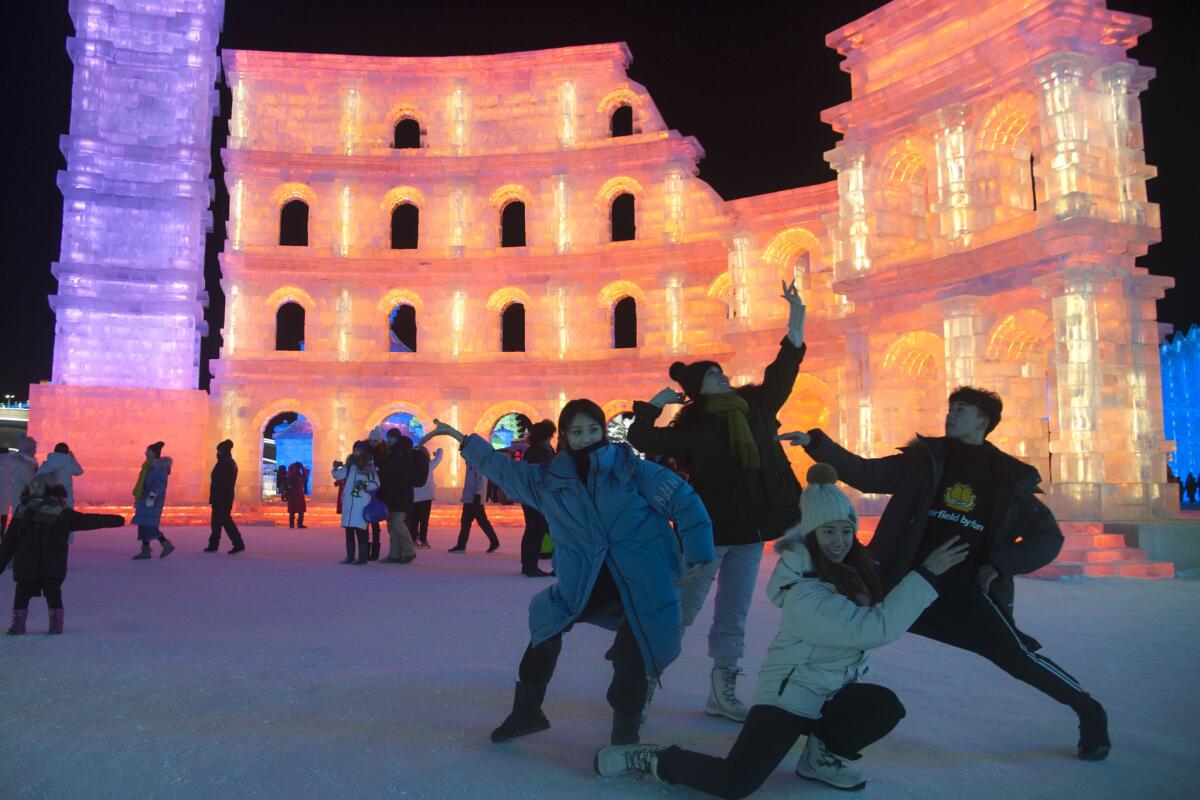
We ate the candy-coated strawberry skewers sold everywhere, shared a beautifully shaped waffle made by a street vendor, and wandered the stalls of a food market before stopping for hot chocolate and egg custard pastries at Holliland Bakery.
In an effort to keep my younger son fed, we compromised and ate at McDonald’s for breakfast (prices were similar to those in Los Angeles), then tried local food for other meals.
We ended up loving Oriental King of Dumplings. The menu is in Chinese, English and Russian. The beef dumplings were great, but I didn’t expect chicken with vermicelli noodles to be a brown dish with pungent mushrooms and thick gelatinous noodles.
We had a good laugh when we asked the server for napkins. She understood, and instead brought us plastic gloves to put on our hands. They worked.
Eating the local cuisine is much cheaper than eating anything resembling Western food, but there are chains such as KFC, Pizza Hut and Starbucks for people who prefer something familiar.
Few Chinese restaurants had English signage, but there were pictures of what they sold to make ordering easier. It turned out the ones with English signage are all part of larger chains.
My favorite part of the trip was walking a few blocks from our hotel to Zhaolin Park, a small amusement park in the middle of the city. The rides were closed for the winter, but the park had ice sculptures, including one of a large sailing ship, an ice maze and two good ice slides.
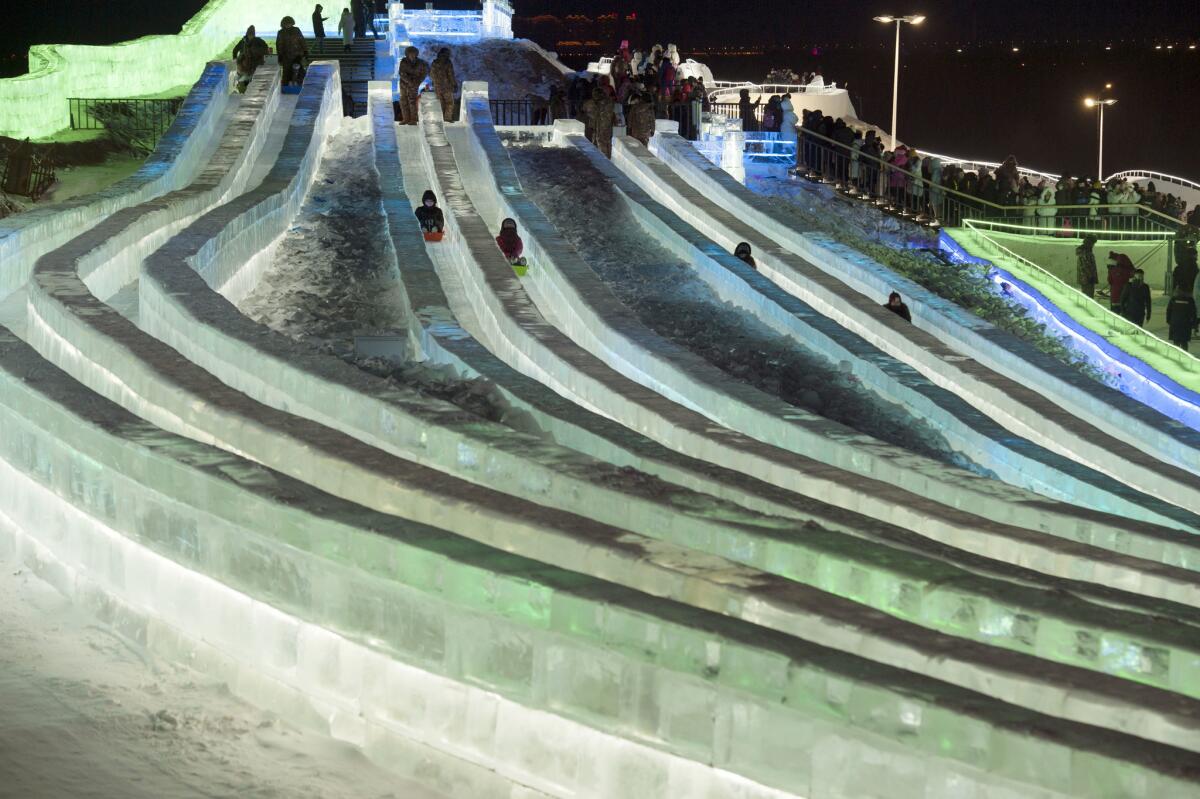
It was quiet and almost empty, unlike the ice festival. We strolled through the entire place and enjoyed the feeling of stillness that comes from being in the middle of a frozen world.
If you go
THE BEST WAY TO HARBIN, CHINA
From LAX, Air China, Asiana, China Eastern, Sichuan, China Southern, American, Delta and United offer connecting service (change of planes) to Harbin. Restricted round-trip airfare from $1,019, including taxes and fees.
You will need a visa to travel to China. They can be obtained at the Chinese consulate in Los Angeles and take about a week to process.
Harbin International Ice and Snow Sculpture Festival: Tickets are available at the festival entrance. The next year’s festival opens Jan. 5.
WHERE TO STAY
Ibis Hotel, 92 Zhaolin St., Harbin, China;
Shangri-La Hotel, 555 You Yi Road, Harbin, China;
Holiday Inn Harbin City Centre, 90 Jingwei St., Harbin, China;
WHERE TO EAT
Oriental King of Dumplings, 168 ShangZhi Main St., Harbin, China;
TO LEARN MORE
China National Tourist Office, 550 N. Brand Blvd., Suite 910, Glendale; (818) 545-7504
More to Read
Sign up for The Wild
We’ll help you find the best places to hike, bike and run, as well as the perfect silent spots for meditation and yoga.
You may occasionally receive promotional content from the Los Angeles Times.
